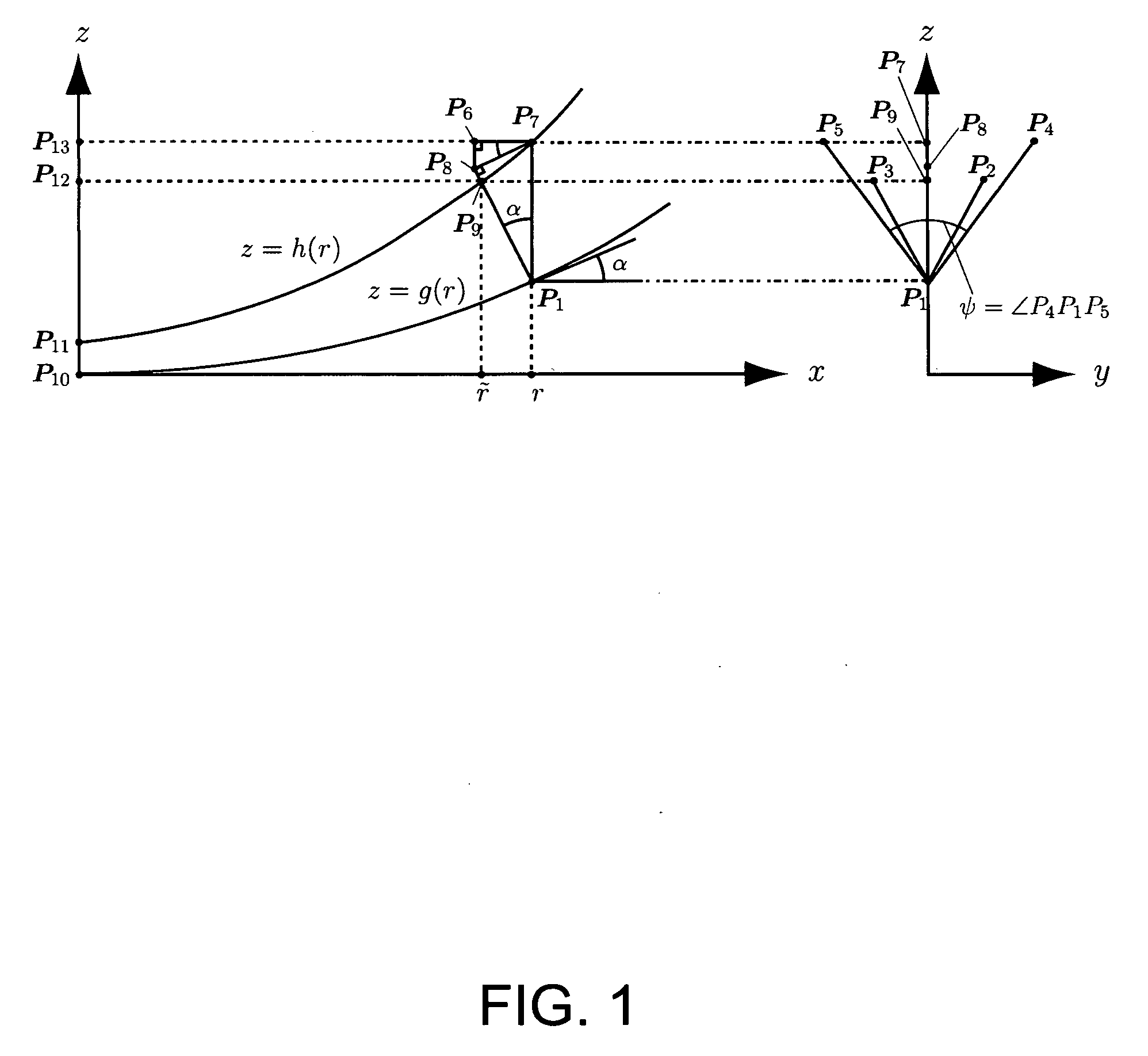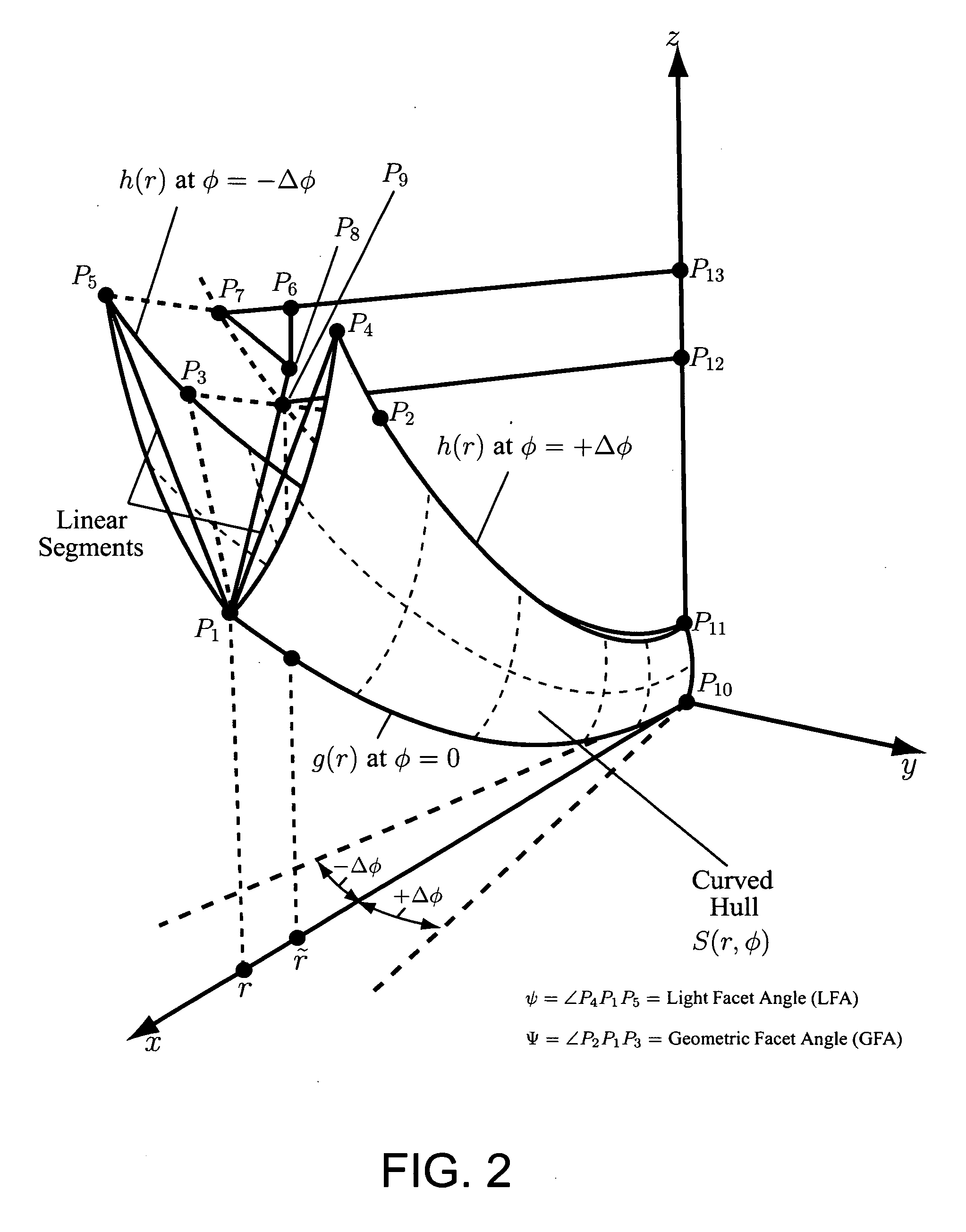The physical processes that are available to the designer of a light
concentrator are limited.
A canonical problem in the area of non-imaging
optics is how to design ultra-efficient concentrators, collimators, and other power transfer devices, which are manufacturable, compact, robust, cost effective, and producible in large volumes.
It is observed that these patents, clearly do not anticipate, teach, or show in any way, the use of a large-area non-planar
facet surface morphology for concentrating light by predominantly Total Internal Reflections.
However, this prior art addresses only a very specific from of optical facet having both a right-angle at each facet apex and linear flat surfaces on the facet sides.
Although these concentrators are based on total internal reflections they are also substantially in error with respect to what
physics is needed to actually implement a
high concentration lens design.
Finally, this prior art is also unable to provide any shaping of the resulting focused
light spot.
The non-imaging lenses they consider are also limited by the extreme sharp or acute angles of the facets making it very hard to manufacture.
Additionally, the approaches presented in their patent are not capable of reaching the highest possible concentration because the focal region is typically placed in the air not the
dielectric so that the advantages of a
refractive index greater than unity are not exploited.
U.S. Pat. No. 6,252,155 issued to Ugar Ortabasi on Jun. 6, 2001 deals with concentrators of type RGXGX, which are based on the classical compound
parabolic concentrator and are not capable of being made physically compact and also require multiple distinct parts for fabrication instead of just one compact transparent dielectric part.
The first
disadvantage of the prior art is that they use a large area of mirrored surfaces for the primary reflecting surface.
These mirrored surfaces provide a failure mode for micro-cracks and mirror detachments to
attack the optical
system—especially over
extended time periods (decades) of thermal
cycling.
The second
disadvantage of the prior art that it does not have a built in means to control the shape of the final
light spot at the output focal region.
The third
disadvantage of the prior art is that it is not transparent and therefore there is no means to provide a visual representation of colors and textures that are located behind, and noncontiguous with, the
concentrator to a remote observer by indirect lighting or by active light sources behind the concentrator.
The prior art is therefore less aesthetically appealing to humans and is less desirable for unobtrusive integration into buildings and other platforms where the aesthetic function is required.
The fourth disadvantage of the prior art again results from the fact that the concentrator is not completely transparent and therefore there is no direct way to provide diffuse light to an observer or
system that is behind the lens or array of concentrator lenses.
The fifth disadvantage is that the prior art is not integrated with a means for dissipating the energy from thermal heating at the concentrated
light spot.
The sixth disadvantage is that the prior art is typically not very thin and low profile.
The seventh disadvantage is that some of the prior art exhibits a lack of broad-band capability due to material and structural dispersion of light.
The eighth disadvantage of the prior art is that it is typically difficult to manufacture.
The ninth disadvantage of the prior art is that it does not allow for the easy formation of arrays of lenses.
The tenth disadvantage of the prior art is that most optical elements are rotationally or transitionally symmetric, which leads to rotational and translational
skew invariance.
This invariance tends to limit the concentration performance beyond that suggested by the conservation of etendue.
The eleventh disadvantage of the prior art is that when curved facets are employed they tend to be small structures relative to the size of the largest dimension of the device and to incorporate very acute angles at their apex thereby making them difficult to manufacture and fragile.
The twelfth disadvantage is that the prior art can not provide both concentrated light and dispersed light to both a high efficiency photovoltaic
cell that uses only directly concentrated light and to thin-film photovoltaic cells for dispersed light simultaneously.
While all of these disadvantages may not exist for any one particular prior art design all of the previously mentioned sources of prior art do suffer from one or more of the above stated deficits.
“Unprotected Total Internal Reflection (UTIR)” as used herein refers to an
optical surface that provides Total Internal Reflection and is not shielded from environmental elements like
dirt or aerosols, which would adhere to said optical surface and reduce the efficiency of the Total Internal Reflection process.
Unfortunately, this last equation is not a closed analytical relation because it requires that Eq.
Note that the greater the
refractive index ninside relative to noutside the larger the acceptance angle of a
cone of light rays and also the larger the potential final concentration of light, however, the greater the mismatch in refractive indices between the surrounding air and the lens—this may increase reflection losses.noutside—Typically air.
Note that the linear facet control plane is the most rudimentary facet structure possible and in general will have associated with it many problems that need correction.
 Login to View More
Login to View More  Login to View More
Login to View More 


